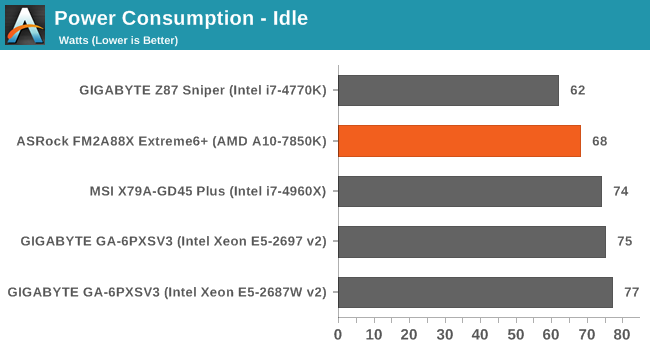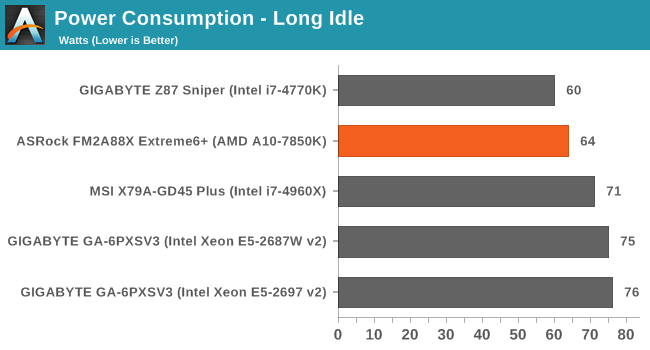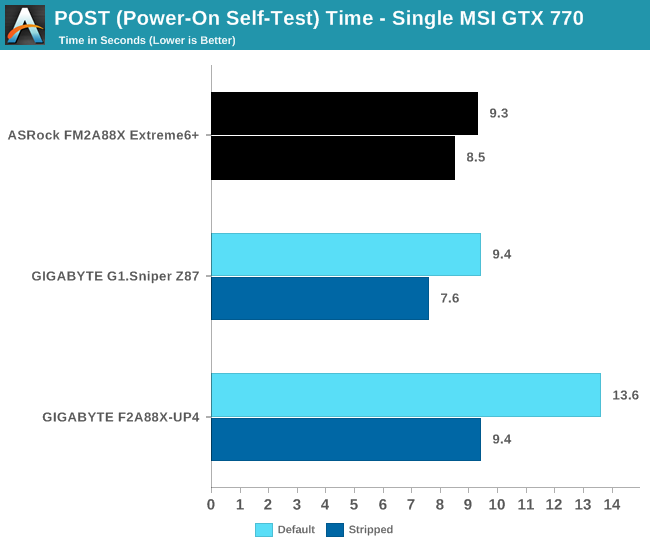ASRock FM2A88X Extreme6+ Review
by Ian Cutress on March 19, 2014 11:59 AM ESTMany thanks to...
We must thank the following companies for kindly providing hardware for our test bed:
Thank you to OCZ for providing us with 1250W Gold Power Supplies and SSDs.
Thank you to G.Skill and ADATA for providing us with memory kits.
Thank you to Corsair for providing us with an AX1200i PSU, Corsair H80i CLC and 16GB 2400C10 memory.
Thank you to ASUS for providing us with the AMD HD7970 GPUs and some IO Testing kit.
Thank you to MSI for providing us with the NVIDIA GTX 770 Lightning GPUs.
Thank you to Rosewill for providing us with the 500W Platinum Power Supply for mITX testing, BlackHawk Ultra, and 1600W Hercules PSU for extreme dual CPU + quad GPU testing, and RK-9100 keyboards.
Thank you to ASRock for providing us with the 802.11ac wireless router for testing.
| Test Setup | |
| Processor |
AMD A10-7850K (ES) 2 Modules, 4 Threads 3700 MHz, 4000 MHz Turbo 4MB L2 Cache |
| Motherboards | ASRock FM2A88X Extreme6+ |
| Cooling |
Corsair H80i Thermalright TRUE Copper |
| Power Supply |
OCZ 1250W Gold ZX Series Corsair AX1200i Platinum PSU |
| Memory | AMD Gaming 2x8GB DDR3-2133 10-11-11 Kit |
| Memory Settings | XMP |
| Video Cards |
MSI GTX 770 Lightning 2GB (1150/1202 Boost) ASUS HD7970 3GB (Reference) |
| Video Drivers |
Catalyst 13.12 NVIDIA Drivers 332.21 |
| Hard Drive | OCZ Vertex 3 256GB |
| Optical Drive | LG GH22NS50 |
| Case | Open Test Bed |
| Operating System | Windows 7 64-bit SP1 |
| USB 2/3 Testing | OCZ Vertex 3 240GB with SATA->USB Adaptor |
| WiFi Testing | D-Link DIR-865L 802.11ac Dual Band Router |
Power Consumption
Power consumption was tested on the system as a whole with a wall meter connected to the OCZ 1250W power supply, while in a single MSI GTX 770 Lightning GPU configuration. This power supply is Gold rated, and as I am in the UK on a 230-240 V supply, leads to ~75% efficiency > 50W, and 90%+ efficiency at 250W, which is suitable for both idle and multi-GPU loading. This method of power reading allows us to compare the power management of the UEFI and the board to supply components with power under load, and includes typical PSU losses due to efficiency. These are the real world values that consumers may expect from a typical system (minus the monitor) using this motherboard.
While this method for power measurement may not be ideal, and you feel these numbers are not representative due to the high wattage power supply being used (we use the same PSU to remain consistent over a series of reviews, and the fact that some boards on our test bed get tested with three or four high powered GPUs), the important point to take away is the relationship between the numbers. These boards are all under the same conditions, and thus the differences between them should be easy to spot.



Windows 7 POST Time
Different motherboards have different POST sequences before an operating system is initialized. A lot of this is dependent on the board itself, and POST boot time is determined by the controllers on board (and the sequence of how those extras are organized). As part of our testing, we are now going to look at the POST Boot Time - this is the time from pressing the ON button on the computer to when Windows 7 starts loading. (We discount Windows loading as it is highly variable given Windows specific features.) These results are subject to human error, so please allow +/- 1 second in these results.

ASRock have historically been good with POST times, and under 10 seconds is a good score.










44 Comments
View All Comments
niva - Wednesday, March 19, 2014 - link
These benchmarks are making me depressed for AMD CPUs. I guess it's time to switch to Intel after not having purchased an Intel chip since 1996.nathanddrews - Wednesday, March 19, 2014 - link
Come on in, the water's fine.Malorcus - Wednesday, March 19, 2014 - link
I hear you man, I did the same with my current Ive Bridge CPU. I am looking to build a media computer using an AMD APU though. They still have their niche, but it is not in high end computing/gaming.ddriver - Wednesday, March 19, 2014 - link
You'd be surprised by the amount of needed and commercially viable tasks for which those poor CPUs are more than fast enough. It is a sad thing to see AMD struggling to compete with Intel's value products.Fallen Kell - Thursday, March 20, 2014 - link
AMD has sadly not had a real competing product in the high end side for 6 or 7 years now. On the low end, AMD was competing, until Intel decided to compete in this market segment. The last two updates that Intel has made were more focused on the lower end than on the high end. This is finally cutting into the one thing keeping AMD alive. I really hope AMD does survive because those of us that are old enough to remember know that Intel hates the consumer and only really pushes technology when it is competing. We would have CPU's that are only soldered directly into motherboards with no ability to upgrade, completely locked down CPUs with no ability to overclock, locked in memory bus speeds that are tiered based on the CPU/motherboard that you purchased with higher performance memory compatibility costing you extra, etc., etc....But I really don't see a way that AMD can compete at this point. They are still hemorrhaging money (not nearly as bad as a year ago when they lost $1.2 BILLION, but even after restructuring to cut 31% of their operating costs, they still lost $162 million last year). While I understood the reason for acquiring ATI, I believe ATI is worse off due to that acquisition. ATI went from being a profitable company competing well in their market, to one that is losing money and is seemingly almost a generation behind Nvidia in their offerings (I say this based on the fact that the brand new released top of the line AMD graphics cards can barely beat the last generation of cards from Nvidia in performance and can not come anywhere near the Nvidia offerings in power/performance or heat/performance, and Nvidia is getting ready to release its true next generation of cards even while they simply released the last generation of cards at their full potential to beat AMD's current cards now that AMD finally had a competing product). The major losses that AMD as a whole has, is taking its toll on the R&D AMD can afford to do in terms of increasing the efficiency of their designed with respect to power and cooling requirements while still being able to push the performance of their cards.
Demiurge - Friday, March 21, 2014 - link
Funny, I thought the same thing about Intel CPU's when GPU's started to encroach on the high performance features such as physics, ray-tracing, signal processing, and other high intensity applications. There's a bigger picture that I think a lot of people miss. The market has already shifted away from CPU's being the centerpiece of high performance applications. AMD has the right strategy with buying ATI and the paradigm of Heterogeneous Computing, but like Intel with the P4: it's too little too late. If they had the software, they might've been able to pull this off, but that is exactly what they are trying to do with Mantle. I think only unanimous adoption would've guaranteed a win. It was a big risk, and it would have been an amazing upstart, but I don't think it will pay off as much as they need it to. Just a modest opinion... and so a long rant ends... ;-)pandemonium - Thursday, March 20, 2014 - link
AMD hasn't been competitive to Intel for the consumer since 1999 or so? They've always been cheaper, and always been far lower in gaming and general desktop usage results as well. You are very, very, very late to the party, lol.mr_tawan - Thursday, March 20, 2014 - link
I believe it was Intel Core series (2006) that started to get ahead of AMD's CPU. Before that, AMD CPUs was both perform better and cheaper. Intel CPUs were power hungry and expensive while did not yield excellent performance.The raw ALU performance on the current line of AMD CPU is quite low because of the design decision to reduce the space occupied by the CPU while add even more GPU on the die, and then make them work together more nicely. It's the direction the AMD heads to.
I believe that one day even the FX line would be APU just like those A-series.
Vinny DePaul - Thursday, March 20, 2014 - link
I feel your pain. I am an AMD fan. I want to keep using AMD but the CPU is running too hot. It is heating up the room! I switch to Intel. It is just easier.... I hope the AMD's involvement in PS4 and Xbox One will shape the future in games and software.Xpl1c1t - Thursday, March 20, 2014 - link
This is exactly what I did going from a Athlon XP Palomino, to Athlon 64 Venice, to a Core i5 Lynnfield.I'd consider purchasing an AMD processor again if the whole APU thing becomes quite competent and powerful at a smaller and more efficient node. I'd promptly and gladly buy an APU with the equivalent of 2 IVB cores and a 7870 onboard if it could me mounted on a Pico-ITX board...